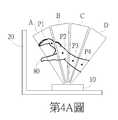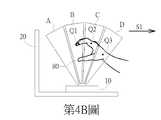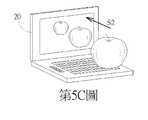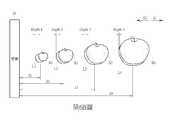TW202004480A - 3D display with gesture recognition function - Google Patents
3D display with gesture recognition functionDownload PDFInfo
- Publication number
- TW202004480A TW202004480ATW107118096ATW107118096ATW202004480ATW 202004480 ATW202004480 ATW 202004480ATW 107118096 ATW107118096 ATW 107118096ATW 107118096 ATW107118096 ATW 107118096ATW 202004480 ATW202004480 ATW 202004480A
- Authority
- TW
- Taiwan
- Prior art keywords
- value
- screen
- gesture
- centroid
- depth
- Prior art date
Links
Images
Classifications
- G—PHYSICS
- G06—COMPUTING OR CALCULATING; COUNTING
- G06F—ELECTRIC DIGITAL DATA PROCESSING
- G06F3/00—Input arrangements for transferring data to be processed into a form capable of being handled by the computer; Output arrangements for transferring data from processing unit to output unit, e.g. interface arrangements
- G06F3/01—Input arrangements or combined input and output arrangements for interaction between user and computer
- G06F3/017—Gesture based interaction, e.g. based on a set of recognized hand gestures
- G—PHYSICS
- G06—COMPUTING OR CALCULATING; COUNTING
- G06F—ELECTRIC DIGITAL DATA PROCESSING
- G06F3/00—Input arrangements for transferring data to be processed into a form capable of being handled by the computer; Output arrangements for transferring data from processing unit to output unit, e.g. interface arrangements
- G06F3/01—Input arrangements or combined input and output arrangements for interaction between user and computer
- G06F3/03—Arrangements for converting the position or the displacement of a member into a coded form
- G06F3/0304—Detection arrangements using opto-electronic means
- G—PHYSICS
- G06—COMPUTING OR CALCULATING; COUNTING
- G06T—IMAGE DATA PROCESSING OR GENERATION, IN GENERAL
- G06T19/00—Manipulating 3D models or images for computer graphics
- G06T19/20—Editing of 3D images, e.g. changing shapes or colours, aligning objects or positioning parts
- G—PHYSICS
- G06—COMPUTING OR CALCULATING; COUNTING
- G06V—IMAGE OR VIDEO RECOGNITION OR UNDERSTANDING
- G06V40/00—Recognition of biometric, human-related or animal-related patterns in image or video data
- G06V40/10—Human or animal bodies, e.g. vehicle occupants or pedestrians; Body parts, e.g. hands
- G06V40/107—Static hand or arm
- G—PHYSICS
- G06—COMPUTING OR CALCULATING; COUNTING
- G06V—IMAGE OR VIDEO RECOGNITION OR UNDERSTANDING
- G06V40/00—Recognition of biometric, human-related or animal-related patterns in image or video data
- G06V40/20—Movements or behaviour, e.g. gesture recognition
- G06V40/28—Recognition of hand or arm movements, e.g. recognition of deaf sign language
- G—PHYSICS
- G06—COMPUTING OR CALCULATING; COUNTING
- G06T—IMAGE DATA PROCESSING OR GENERATION, IN GENERAL
- G06T2219/00—Indexing scheme for manipulating 3D models or images for computer graphics
- G06T2219/20—Indexing scheme for editing of 3D models
- G06T2219/2016—Rotation, translation, scaling
Landscapes
- Engineering & Computer Science (AREA)
- Theoretical Computer Science (AREA)
- General Engineering & Computer Science (AREA)
- Physics & Mathematics (AREA)
- General Physics & Mathematics (AREA)
- Human Computer Interaction (AREA)
- Multimedia (AREA)
- Computer Hardware Design (AREA)
- Computer Graphics (AREA)
- Software Systems (AREA)
- Architecture (AREA)
- Health & Medical Sciences (AREA)
- Computer Vision & Pattern Recognition (AREA)
- General Health & Medical Sciences (AREA)
- Psychiatry (AREA)
- Social Psychology (AREA)
- Controls And Circuits For Display Device (AREA)
- Position Input By Displaying (AREA)
Abstract
Description
Translated fromChinese本發明相關於一種具備手勢感測和景深調整功能之三維顯示器,尤指一種低成本、低耗能且體積小的具備手勢感測和景深調整功能之三維顯示器。The invention relates to a three-dimensional display with gesture sensing and depth-of-field adjustment functions, in particular to a low-cost, low-energy and small-sized three-dimensional display with gesture sensing and depth-of-field adjustment functions.
目前遠距感測技術使用非接觸式的量測顯像,常見的有微波(microwave)、聲波(acoustic wave)、紅外線(Infrared)、雷射(laser)、立體視覺法(stereoscopic)等,這些大都屬於三角測距(triangulation)的應用。三維(3D)顯示器搭配手勢感測的互動概念雖然早已提出,但一直無法輕易實作,主要原因之一在於手勢感測的攝影機感測元件體積龐大,耗電量大,且往往價格昂貴,不適合安裝在一般的筆記型電腦、桌上型電腦,或可攜式電子裝置上。再者,3D顯示器的效果(像是景深)無法隨著手勢互動改變,使得顯示效果在手勢互動時顯得不自然。At present, long-distance sensing technology uses non-contact measurement imaging, and common ones include microwave, acoustic wave, infrared, laser, stereoscopic, etc. Most of them belong to the application of triangulation. Although the interactive concept of three-dimensional (3D) display with gesture sensing has been proposed for a long time, it has not been easy to implement. One of the main reasons is that the camera sensing component of gesture sensing is bulky, consumes a lot of power, and is often expensive and unsuitable. Installed on general notebook computers, desktop computers, or portable electronic devices. Furthermore, the effect of the 3D display (such as depth of field) cannot be changed with gesture interaction, making the display effect appear unnatural during gesture interaction.
因此,需要一種低成本、低耗能、體積小的具備手勢感測和景深調整功能之3D顯示器。Therefore, there is a need for a low-cost, low-energy, small-size 3D display with gesture sensing and depth-of-field adjustment functions.
本發明提供一種能具備手勢感測功能之三維顯示器,其包含一螢幕、一景深偵測單元,以及一處理電路。該螢幕用來顯示一三維物件。該景深偵測單元包含複數組紅外線感測器。該處理電路用來接收該複數組紅外線感測器之光學訊號,進而提供該複數組紅外線感測器之掃描區域所得之資料;依據該複數組紅外線感測器之掃描區域所得之資料判斷是否偵測到一手勢;計算該手勢之一個或多個形心的位置;依據該一個或多個形心之移動資訊來辨識出該手勢和該螢幕之間的一距離變化;且依據該距離變化指示該螢幕以對應該距離變化之方式調整該三維物件和該螢幕之間之視覺距離、該三維物件之大小,以及該三維物件之景深的至少其中之一。The invention provides a three-dimensional display capable of gesture sensing function, which includes a screen, a depth of field detection unit, and a processing circuit. The screen is used to display a three-dimensional object. The depth-of-field detection unit includes a plurality of infrared sensors. The processing circuit is used to receive the optical signal of the complex array infrared sensor, and then provide the data obtained by the scanning area of the complex array infrared sensor; according to the data obtained by the scanning area of the complex array infrared sensor, determine whether to detect A gesture is detected; the position of one or more centroids of the gesture is calculated; a change in the distance between the gesture and the screen is recognized based on the movement information of the one or more centroids; and the indication of the change in distance The screen adjusts at least one of the visual distance between the three-dimensional object and the screen, the size of the three-dimensional object, and the depth of field of the three-dimensional object in a manner corresponding to the change in the distance.
第1圖為本發明實施例中一種具備手勢感測功能之3D顯示器100的功能方塊圖。3D顯示器100包含一景深偵測單元10、一螢幕20,以及一處理電路30。景深偵測單元10包含複數組紅外線感測器(infrared sensor, IR sensor)SR1~SRM,其中M為大於1之整數。處理電路30可依據景深偵測單元10之掃描區域所得之資料來調整螢幕20所顯示物件之景深。FIG. 1 is a functional block diagram of a
在本實施例中,3D顯示器100之螢幕20包含液晶面板,其顯示影像區分為左眼影像像素和右眼影像像素,利用液晶面板前方之平行遮罩或柱狀透鏡同時把左眼影像像素和右眼影像像素分別投射至左右眼以形成兩眼視差的效果,進而讓觀眾看到立體影像。左眼影像和右眼影像之間的差異稱為景深(depth),本實施例之3D顯示器100可透過設置於液晶面板兩側之上下透明電極來改變液晶分子的旋轉角度以調整景深。當兩眼的影像差異越大,觀看者看到3D 影像的立體感就越明顯;當兩眼的影像差異越小,觀看者看到3D 影像的立體感就越不明顯。在其他實施例中,螢幕20也可以採用其他合適的3D顯示技術實現。In this embodiment, the
在本實施例中,處理電路30可以採用處理器或特殊應用積體電路(application-specific integrated circuit, ASIC)等電路元件來實施。然而,處理電路30之實施方式並不限定本發明之範疇。In this embodiment, the
在本實施例中,3D顯示器100可為筆記型電腦、桌上型電腦或電視等具備顯示功能之裝置。景深偵測單元10設置於螢幕20之有效顯示範圍的下方,使得紅外線感測器SR1~SRM之掃描區域能夠偵測手勢和螢幕20之間的距離變化。在一實施例中,螢幕20之有效顯示範圍可由螢幕20之可視角度來決定,亦即在可視角度內使用者能從不一樣的方位清晰地(符合預定畫質、對比細節、亮度和色彩變化)看見螢幕20上所有顯示內容。然而,螢幕20之有效顯示範圍大小並不限定本發明之範疇。In this embodiment, the
第2圖為本發明實施例中3D顯示器100的示意圖。在此實施例中,3D顯示器100為筆記型電腦,其中螢幕20設置於一蓋體40上,景深偵測單元10設置於一底部殼體50上,而處理電路30(未顯示)設置於底部殼體50內。蓋體40樞接於底部殼體50,使得使用者可調整蓋體40和底部殼體50之間的角度。然而,3D顯示器100之種類並不限定本發明之範疇。FIG. 2 is a schematic diagram of the
為了說明目的,第2圖顯示了M=4時之實施例,然而M之值並不限定本發明之範疇。在第2圖所示之3D顯示器100中,承載螢幕20之蓋體40位於底部殼體50之第一側,而景深偵測單元10之紅外線感測器SR1~SR4位於底部殼體50之第二側,其中第一側和第二側為底部殼體50之兩相鄰側。For the purpose of illustration, FIG. 2 shows an embodiment when M=4, but the value of M does not limit the scope of the present invention. In the
本實施例之3D顯示器100採用時差測距之技術來提供調整景深的功能。由景深偵測單元10內之紅外線感測器發射紅外線光束,紅外線光束打到物體表面後反射,再接收訊號並記錄時間。由於光速為一已知條件,紅外線光束訊號往返一趟的時間即可換算為訊號所行走的距離,進而得知物體的位置。The
第3圖顯示了本發明實施例中景深偵測單元10運作時之示意圖。景深偵測單元10中紅外線感測器SR1之掃描區域A、紅外線感測器SR2之掃描區域B、外線感測器SRU3之掃描區域C和紅外線感測器SRU4之掃描區域D分別可為螢幕20前之錐形範圍,因此可監控螢幕20之有效顯示範圍內的手勢。然而,掃描區域A~D之形狀並不限定本發明之範疇。FIG. 3 shows a schematic diagram of the depth of
第4A~4C圖為本發明實施例中景深偵測單元10運作時之示意圖。第4A和4B圖依序顯示了使用者手掌80在下達抓近手勢時的過程。在第4A圖所示的初始狀態下的第一時間點,假設在使用者的手掌80出現在掃描區域A~D內,景深偵測單元10可偵測到對應於使用者手掌80的4個形心座標P1~P4。在第4B圖所示的結束狀態下的第二時間點,假設在使用者的手掌80出現在掃描區域B~D內,景深偵測單元10可偵測到對應於使用者手掌80的3個形心座標Q1~Q3。由於第二時間點晚於第一時間點,且依據形心座標P1~P4和Q1~Q3之位置變化,處理電路30可判斷出各形心之移動方向,當每一形心或大多數形心皆遠離螢幕20移動,如第4B圖中之箭頭S1(朝靠近使用者的方向)所示。依據各形心之移動方向,處理電路30可判斷出使用者手掌80在下達抓近手勢,進而依此指示螢幕20所顯示的物件在視覺上呈現被使用者拉近的效果,如第4C圖所示,三維物件往箭頭S1方向移動,即朝靠近使用者的方向移動,使用者會觀察到三維物件和螢幕20的視覺距離變遠及三維物件的尺寸變大。4A to 4C are schematic diagrams of the depth of
第5A~5C圖為本發明實施例中景深偵測單元10運作時之示意圖。第5A和5B圖依序顯示了使用者手掌80在下達推遠手勢時的過程。在第5A圖所示的初始狀態下的第三時間點,假設在使用者的手掌80出現在掃描區域B~D內,景深偵測單元10可偵測到對應於手掌80的3個形心座標P1~P3。在第5B圖所示的結束狀態下的第四時間點,假設在使用者的手掌80出現在掃描區域A~D內,景深偵測單元10可偵測到對應於手掌80的4個形心座標Q1~Q4。由於第四時間點晚於第三時間點,且依據形心座標P1~P3和Q1~Q4之位置變化,處理電路30可判斷出各形心之移動方向,其中每一形心或大多數形心皆接近螢幕20移動,如第5B圖中之箭頭S2(朝遠離使用者的方向)所示。依據各形心之移動方向,處理電路30可判斷出使用者手掌80在下達推遠手勢,進而依此指示螢幕20所顯示的物件在視覺上呈現被使用者推遠的效果,如第5C圖所示,三維物件往箭頭S2方向移動,即朝遠離使用者的方向移動,使用者會觀察到三維物件和螢幕20的視覺距離變近及三維物件的尺寸變小。5A~5C are schematic diagrams of the depth of
在上述的實施例中,形心座標由景深偵測單元10依據所偵測的信號而產生。在另一實施例中,形心座標也可以由景深偵測單元10將所偵測的信號傳送至信號處理電路30,而由信號處理電路30產生。In the above embodiment, the centroid coordinates are generated by the depth of
第6A和6B圖為本發明實施例中針對拉近手勢或推遠手勢來調整顯示影像時之示意圖。L1~L4分別代表螢幕20與所顯示物件間的視覺距離為d1~d4時之左眼影像,R1~R4分別代表螢幕20與所顯示物件間的視覺距離為d1~d4時之右眼影像,Depth 1代表左眼影像L1和右眼影像R1的景深,Depth 2代表左眼影像L2和右眼影像R2的景深,Depth 3代表左眼影像L3和右眼影像R3的景深,Depth 4代表左眼影像L4和右眼影像R4的景深,箭頭S1之方向對應針對拉近手勢時螢幕20改變其顯示物件之過程,而箭頭S2之方向對應針對推遠手勢時螢幕20改變其顯示物件之過程。FIGS. 6A and 6B are schematic diagrams when the display image is adjusted for the zoom-in gesture or the zoom-out gesture in the embodiment of the present invention. L1~L4 respectively represent the left eye image when the visual distance between the
由於使用者可能有不同的視覺偏好,因此,在上述的實施例中,可依據螢幕20的大小、顯示物件的結構、背景照明度和觀眾年紀等參數來設定螢幕20及所顯示物件之視覺距離為d1~d4時,所對應左右眼影像景深Depth 1~ Depth 4之值。例如第6A和6B圖所示,當物件離螢幕20越遠且離使用者越近時,相對應之左右眼影像越大(R4> R3> R2> R1且L4> L3> L2> L1)。在第6A圖所示之實施例中,當物件離螢幕20越遠且離使用者越近時,可設置相對應之左右眼影像的景深越大(Depth 4> Depth 3> Depth 2> Depth 1)。在第6B圖所示之實施例中,當物件離螢幕20越遠且離使用者越近時時,可設置相對應之左右眼影像的景深越小(Depth 4< Depth 3< Depth 2< Depth 1)。然而,第6A和6B圖所示漸進式景深調整僅為實施例,並不限定本發明之範疇。例如,有些使用者也可以依據視覺偏好,而將對應於不同視覺距離d1~d4時的左右眼影像景深Depth 1~ Depth 4皆設置為相同的數值。Since users may have different visual preferences, in the above embodiments, the visual distance between the
在上述實施例中,藉由將景深偵測單元10及螢幕20設置於底部殼體50的相鄰兩側,並將景深偵測單元10的紅外線感測器SR1~SR4的排列方式及對應的掃描區域設置為可偵測垂直於螢幕20方向的手勢動作,而能對應地調整螢幕20所顯示的三維物件和螢幕20之間的視覺距離、三維物件之尺寸大小以及三維物件的景深。在另一實施例中,景深偵測單元10也可以設置於其他適當位置,而不限於螢幕20的相鄰側,並且藉由將紅外線感測器SR1~SR4的排列方式及對應的掃描區域設置為可偵測垂直於螢幕20方向的手勢動作,而能對應地調整螢幕20所顯示的三維物件和螢幕20之間的視覺距離、三維物件之尺寸大小以及三維物件的景深。In the above embodiment, by arranging the
綜上所述,本發明之3D顯示器使用低成本、低耗能且體積小的紅外線感測器來偵測手勢和螢幕的距離,再依此指示螢幕讓3D顯示物件隨著手勢互動來調整其大小、景深以及和螢幕的距離,以提供自然的3D顯示效果。 以上所述僅為本發明之較佳實施例,凡依本發明申請專利範圍所做之均等變化與修飾,皆應屬本發明之涵蓋範圍。In summary, the 3D display of the present invention uses a low-cost, low-energy, and small-size infrared sensor to detect the distance between the gesture and the screen, and then instructs the screen to allow the 3D display object to adjust its interaction with the gesture The size, depth of field and distance from the screen to provide a natural 3D display. The above are only the preferred embodiments of the present invention, and all changes and modifications made in accordance with the scope of the patent application of the present invention shall fall within the scope of the present invention.
10‧‧‧景深偵測單元20‧‧‧螢幕30‧‧‧處理電路40‧‧‧蓋體50‧‧‧底部殼體80‧‧‧手掌100‧‧‧3D顯示器A~D‧‧‧掃描區域S1、S2‧‧‧箭頭P1~P4、Q1~Q4‧‧‧形心座標SR1~SRM‧‧‧紅外線感測器d1~d4‧‧‧視覺距離Depth‧‧‧1~Depth4‧‧‧景深L1~L4‧‧‧左眼影像R1~R4‧‧‧右眼影像10‧‧‧
第1圖為本發明實施例中一種具備手勢感測功能之3D顯示器的功能方塊圖。 第2圖為本發明實施例中3D顯示器的示意圖。 第3圖顯示了本發明實施例中景深偵測單元運作時之示意圖。 第4A~4C圖為本發明實施例中景深偵測單元運作時之示意圖。 第5A~5C圖為本發明實施例中景深偵測單元運作時之示意圖。 第6A和6B圖為本發明實施例中針對拉近手勢或推遠手勢來調整顯示影像時之示意圖。FIG. 1 is a functional block diagram of a 3D display with a gesture sensing function according to an embodiment of the invention. FIG. 2 is a schematic diagram of a 3D display in an embodiment of the invention. FIG. 3 shows a schematic diagram of the depth of field detection unit in the embodiment of the present invention. 4A~4C are schematic diagrams of the depth of field detection unit in the embodiment of the present invention. 5A~5C are schematic diagrams of the depth of field detection unit in the embodiment of the present invention. FIGS. 6A and 6B are schematic diagrams when the display image is adjusted for the zoom-in gesture or the zoom-out gesture in the embodiment of the present invention.
10‧‧‧景深偵測單元10‧‧‧Depth of field detection unit
20‧‧‧螢幕20‧‧‧ screen
40‧‧‧蓋體40‧‧‧cover
50‧‧‧底部殼體50‧‧‧Bottom shell
100‧‧‧3D顯示器100‧‧‧3D display
SR1~SR4‧‧‧紅外線感測器SR1 ~SR4 ‧‧‧Infrared sensor
Claims (9)
Translated fromChinesePriority Applications (2)
| Application Number | Priority Date | Filing Date | Title |
|---|---|---|---|
| TW107118096ATWI669653B (en) | 2018-05-28 | 2018-05-28 | 3d display with gesture recognition function |
| US16/109,761US20190361532A1 (en) | 2018-05-28 | 2018-08-23 | 3d display with gesture recognition and depth adjustment function |
Applications Claiming Priority (1)
| Application Number | Priority Date | Filing Date | Title |
|---|---|---|---|
| TW107118096ATWI669653B (en) | 2018-05-28 | 2018-05-28 | 3d display with gesture recognition function |
Publications (2)
| Publication Number | Publication Date |
|---|---|
| TWI669653B TWI669653B (en) | 2019-08-21 |
| TW202004480Atrue TW202004480A (en) | 2020-01-16 |
Family
ID=68316753
Family Applications (1)
| Application Number | Title | Priority Date | Filing Date |
|---|---|---|---|
| TW107118096ATWI669653B (en) | 2018-05-28 | 2018-05-28 | 3d display with gesture recognition function |
Country Status (2)
| Country | Link |
|---|---|
| US (1) | US20190361532A1 (en) |
| TW (1) | TWI669653B (en) |
Families Citing this family (3)
| Publication number | Priority date | Publication date | Assignee | Title |
|---|---|---|---|---|
| WO2021030034A1 (en) | 2019-08-15 | 2021-02-18 | Apple Inc. | Depth mapping using spatial multiplexing of illumination phase |
| CN111581415B (en)* | 2020-03-18 | 2023-07-04 | 时时同云科技(成都)有限责任公司 | Method for determining similar objects, method and equipment for determining object similarity |
| US11763472B1 (en)* | 2020-04-02 | 2023-09-19 | Apple Inc. | Depth mapping with MPI mitigation using reference illumination pattern |
Family Cites Families (6)
| Publication number | Priority date | Publication date | Assignee | Title |
|---|---|---|---|---|
| CN103858074B (en)* | 2011-08-04 | 2018-10-19 | 视力移动技术有限公司 | Systems and methods for interacting with devices via 3D displays |
| CN103135889B (en)* | 2011-12-05 | 2017-06-23 | Lg电子株式会社 | Mobile terminal and its 3D rendering control method |
| US9274608B2 (en)* | 2012-12-13 | 2016-03-01 | Eyesight Mobile Technologies Ltd. | Systems and methods for triggering actions based on touch-free gesture detection |
| EP3201724A4 (en)* | 2014-09-30 | 2018-05-16 | Hewlett-Packard Development Company, L.P. | Gesture based manipulation of three-dimensional images |
| WO2017014692A1 (en)* | 2015-07-21 | 2017-01-26 | Heptagon Micro Optics Pte. Ltd. | Generating a disparity map based on stereo images of a scene |
| US10120454B2 (en)* | 2015-09-04 | 2018-11-06 | Eyesight Mobile Technologies Ltd. | Gesture recognition control device |
- 2018
- 2018-05-28TWTW107118096Apatent/TWI669653B/enactive
- 2018-08-23USUS16/109,761patent/US20190361532A1/ennot_activeAbandoned
Also Published As
| Publication number | Publication date |
|---|---|
| US20190361532A1 (en) | 2019-11-28 |
| TWI669653B (en) | 2019-08-21 |
Similar Documents
| Publication | Publication Date | Title |
|---|---|---|
| JP6123365B2 (en) | Image display system and head-mounted display device | |
| TWI547828B (en) | Calibration of sensors and projector | |
| TWI523493B (en) | Three-dimensional image display device and driving method thereof | |
| US20100283833A1 (en) | Digital image capturing device with stereo image display and touch functions | |
| CN103533340B (en) | The bore hole 3D player method of mobile terminal and mobile terminal | |
| US20120200680A1 (en) | Display device and method for providing 3D image of the display device | |
| CN111857461B (en) | Image display method, device, electronic device, and readable storage medium | |
| CN107092097B (en) | Naked eye 3D display method, apparatus and terminal device | |
| WO2020019548A1 (en) | Glasses-free 3d display method and apparatus based on human eye tracking, and device and medium | |
| US20150009119A1 (en) | Built-in design of camera system for imaging and gesture processing applications | |
| JP2005202153A (en) | Display device and display system | |
| EP2905960A1 (en) | Display apparatus and controlling method thereof | |
| TWI669653B (en) | 3d display with gesture recognition function | |
| US10936053B2 (en) | Interaction system of three-dimensional space and method for operating same | |
| TW201407195A (en) | Auto-stereoscopic display having multi-user tracing function and method thereof | |
| CN103063193A (en) | Method and device for ranging by camera and television | |
| CN107978019A (en) | Augmented reality system and method | |
| JPH09238369A (en) | 3D image display device | |
| WO2011136213A1 (en) | Display device | |
| KR101119781B1 (en) | Stereo Imaging Touch Device | |
| US11144194B2 (en) | Interactive stereoscopic display and interactive sensing method for the same | |
| JP6686319B2 (en) | Image projection device and image display system | |
| CN107483915B (en) | Three-dimensional image control method and device | |
| US20250116879A1 (en) | Driving method for liquid crystal grating, and display apparatus and display method for display apparatus | |
| CN110581987A (en) | 3D display with gesture sensing |










